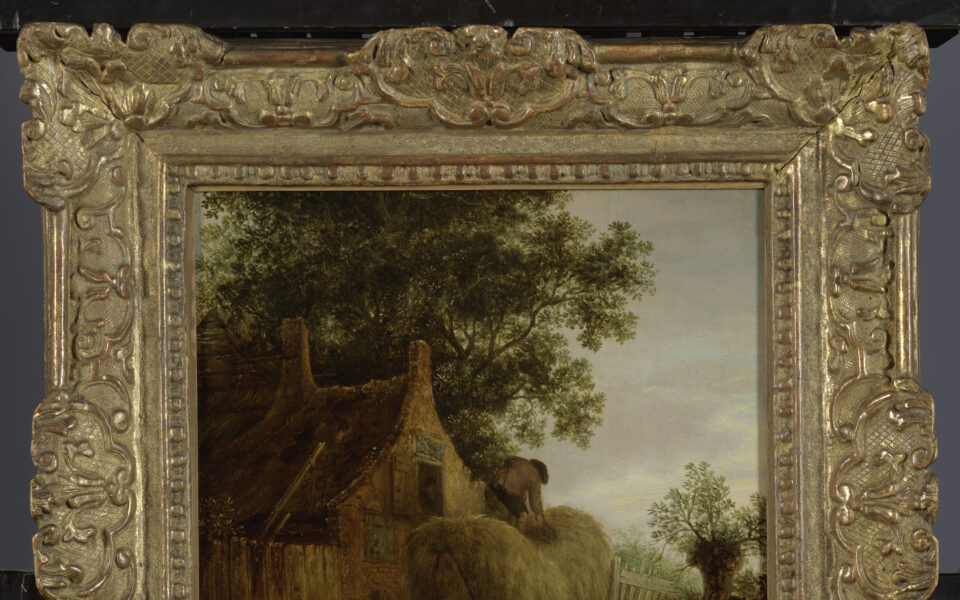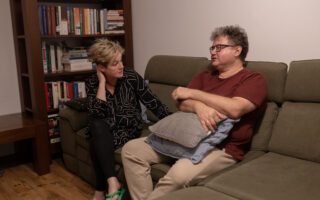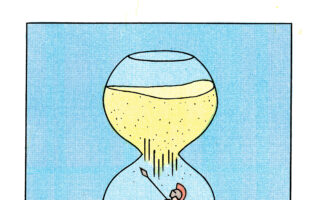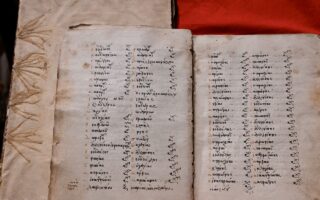Heirs awarded Nazi-looted art are still waiting, 17 years later

In a museum storage depot in Amersfoort, the Netherlands, a 17th-century painting by a Dutch old master is packed away, unseen and unappreciated. Once the property of an elderly British Jewish couple living in France, it was seized by Nazi collaborators during World War II and sold to Hermann Göring, Adolf Hitler’s second-in-command.
Because of an administrative error in the war’s aftermath, it ended up in the Netherlands, where it was displayed in a museum for decades. The collectors’ heirs sought its return in 2006; the country investigated the case and recommended restitution the following year. But the family members still don’t have the painting back, and they don’t know when that will ever happen.
Standing between the family and the painting are a few missing documents and a diligent Dutch civil notary who won’t let the artwork go until he gets them.
“We, the heirs, are regarded in the Dutch system as crooks who are eager to make money on a sale, not as victims of looting,” said Alain Monteagle, a 77-year-old retired history teacher who has led the family’s quest for the painting’s return. “The longer this goes on, the more complicated it becomes, and eventually there will be no one to receive the painting who saw it before the war.”
Linen and Lace
The painting, “Unloading the Hay Wagon,” was one of about 100 by Isaac van Ostade, the son of a Haarlem linen weaver, who died at age 24 in 1649. His works are not among the most sought-after of Dutch 17th-century masters; the highest auction price was about $100,000.
Centuries passed before the oil painting was purchased by John Jaffé, an exporter of Irish linen and lace who was based in Belfast, Northern Ireland, and his wife, Anna Jaffé (born Gluge), the daughter of the king of Belgium’s personal physician. In their old age, the Jaffés bought a villa in Nice, France, and filled it with art by Rembrandt, Francisco Goya, J.M.W. Turner, John Constable and others.
John Jaffé died at age 91 in 1934. Anna Jaffé, who didn’t have children, initially planned to leave her trove of some 200 paintings to the French state. The Van Ostade would have gone to the Louvre. After German Nazi forces invaded France in 1940, she changed her mind and revised her will.
“Considering the new tragic situation,” she wrote, she was leaving the collection to four nieces and nephews to help them escape Europe.
By the time Jaffé died at age 90 in 1942, Nice was under the control of the pro-Nazi Vichy government. Its State Commission for Jewish Affairs seized all of her possessions, from coffeepots to Goya paintings, and put them up for auction, against the objections of her beneficiaries.
Auction house records indicated that the Van Ostade sold to a certain “Madame Bonfils” — of whom nothing else is known — and three months later landed at an art gallery in Paris. Walter Andreas Hofer, Göring’s art buyer, bought it for the reichsmarschall’s personal collection. Once the war was over, it was found at a looted art collection point in Munich and returned, mistakenly, to the Netherlands.
Returned to the Wrong Country
Once returned, the painting was folded into a trove of tens of thousands of looted artworks that the Dutch state was supposed to return to their rightful owners, the vast majority of them Jews. The state organization tasked with finding the owners, however, found such work challenging.
About 75% of Jews from the Netherlands did not survive the war, and those who had returned often had more pressing priorities than seeking lost art. In 1951, the group in charge of returning the art said it had done as much as it could and closed its doors, handing the remaining works to the Netherlands Art Property Collection, known as the NK Collection.
Because its rightful owners were elsewhere, “Unloading the Hay Wagon” went into the NK Collection and was labeled No. 1861. Then it was placed on long-term loan with Museum IJsselstein, not far from Utrecht, where it was displayed for decades.
One of Anna Jaffé’s great-grandnephews, Monteagle, was leading his family’s search for her nearly 200 lost artworks. He found them dispersed across the globe: a Venetian scene by Francesco Guardi in the Louvre; a Constable in the Musée des Beaux-Arts in Switzerland; a Turner at the Kimbell Art Museum in Fort Worth, Texas.
In 2006, having located the Van Ostade in Holland, Monteagle filed a request for restitution with the Dutch Restitution Commission. The following year, its investigation concluded that the Van Ostade “was indeed a case of involuntary loss of possession” and must be returned to the Jaffé heirs.
Monteagle has recovered 11 artworks for the heirs, but the Van Ostade has remained in the Netherlands. Since 2007, three of Monteagle’s elderly relatives, Anna Dervaux, Marianne Gluge and Renée Maistre du Chambon, have died during the wait for the restitution of that painting.
‘One-144th Undivided Share’
In the Netherlands, ever since the 16th century, civil law notaries have been required to validate any kind of official transaction. Quasi-government officials often appointed by the courts, these notaries authorize wills, mortgages and property transfers. Dutch weddings are also often conducted in front of notaries.
After the Van Ostade painting was approved for restitution in 2007, the case landed on the desk of an Amsterdam notary, Maarten R. Meijer, an hourly contractor with the Dutch Cultural Agency, who estimates that he has handled 50 restitution cases for the state in the past two decades.
Meijer works out of a canal-house mansion on the Keizersgracht, or Emperor’s Canal, in Amsterdam. His primary job, he explained, is to verify ownership rights and ensure that the artwork is returned to the rightful beneficiaries. Once he has collected the necessary documents from each of the known heirs, he can send the work back to a mutually agreed-upon destination.
But so far, he said, he has not received all the documents and paperwork required from the family in order to make that transfer happen.
“This is my longest-lasting case ever,” he said in an interview. “I’m a civil law notary, and that means I’m an impartial lawyer acting on behalf of all the parties concerned.”
He said he finds it difficult to work with these heirs, who he said are frustratingly unresponsive. “I do have some of the documents, but not 100%,” he said.
Meijer held up a list he compiled in 2019 that shows the ownership share of each of the 14 known heirs. Some have “one-ninth undivided share” and others merely “one-144th undivided share.”
From each one, he said, he needs valid identification and signed power-of-attorney statements. He is missing the materials from more than four of them, he said. Because three named heirs have died since 2007, he needs the same materials from their beneficiaries as well.
“I can’t go further without 100% of the information,” he said. “I don’t know why it is so difficult.” The roadblocks to return are caused by missing documentation, he said. “My only job is to make sure that this is done in the most efficient way possible.”
Monteagle, who said he went to great lengths about a decade ago to provide Meijer with all the paperwork he requested, said the process has been anything but efficient. In addition to the necessary identifications, he said he has put Meijer in touch with the family’s French notary as well as its Belgian genealogist, Eleanore Delabre.
Delabre is a provenance researcher with ADD Associés in Paris, a probate genealogy firm that represents seven Belgian Jaffé heirs. She said in an email that she attributed the delay to “the excessive formal checks asked by M. Meijer for the Dutch State.”
“There is no confusion about the identity of the heirs or whether the painting must be returned to them,” she added.
Administrative Roadblocks
Although he is frustrated, Monteagle said he does not blame Meijer personally, but he feels that the Dutch system’s reliance on notaries in handling such matters is unreasonably taxing for heirs.
“It’s so frustrating that my old cousins, who knew this painting in the past, couldn’t see it again before they died,” he said.
Monteagle added that in all of the restitution cases around the world he has pursued in the past two decades, the same group of heirs have been involved, and in that time, there have been no arguments about ownership.
Marc J. Masurovsky, a founder of the Holocaust Art Restitution Project in Washington, D.C., said governments often put too many procedural hurdles in front of heirs trying to retrieve stolen art.
“Governments are really loath to step forward to the claimants, so they establish all kinds of administrative roadblocks to impede, delay and outright prevent the return of works deemed to restitutions, even though there is nothing wrong with the claim,” he said. “It’s a means of stalling, stalling, stalling until everyone is dead.”
Anne Webber, co-chair of the Commission for Looted Art in Europe, said that all European restitution agencies require proof of inheritance from heirs, as the Netherlands does, to ensure works are returned to the right people.
On the other hand, she said, some families may need help sorting out their documents.
“It can be enormously difficult for heirs to find the right documentation, because during the Nazi era, families were scattered across many different countries and separated. And inheritance documentation in many cases is not easily found.”
Officials at the Cultural Heritage Agency of the Netherlands in The Hague said the work will be returned.
“Our aim is to give everything back to all the rightful heirs,” said Dolf Muller, a spokesperson for the agency. “We want to do right by everybody. In this case, it’s just difficult.”
He said there is no shortcut for finishing up the paperwork. “We think we have to do right by everyone, because we know we did a lot that’s wrong in the past,” he said. “We try our best to do it as well as we can. Maybe in some cases it takes a very long time to do the right thing, but that’s all that we can do.”
The Jaffé case, he said, is not symptomatic of any larger problem. Usually the Netherlands takes no more than a year or two to return Nazi-looted art.
“This is a unique case, so hopefully it will come to an end,” he said.
Meijer said he is hopeful the return can soon be made.
“The deed is more or less done, but I am still missing things.” He added, “I feel pity for the beneficiaries right now because it is still hanging in the air for many, many years already. I want to finalize all my files; that’s my job.”
The painting remains in a storage depot. As Monteagle noted, the last surviving Jaffé relative who remembers seeing “Unloading the Hay Wagon” before the war is now 95.
“I feel some indignation now,” Monteagle said. “I’m worried that I won’t see it before I die either.”
This article originally appeared in The New York Times.






